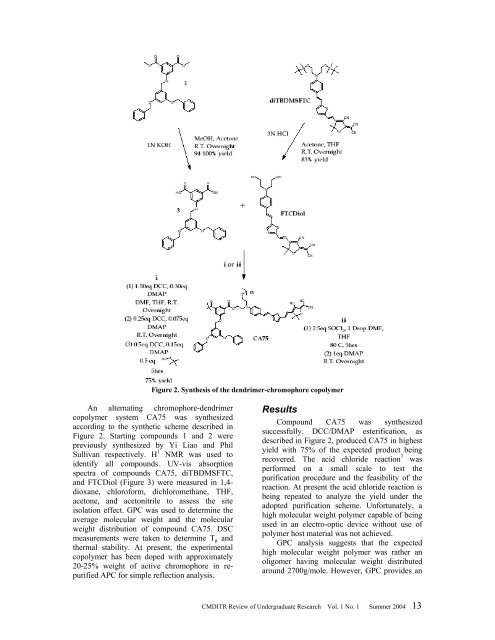CMDITR Review of Undergraduate Research - Pluto - University of ...
CMDITR Review of Undergraduate Research - Pluto - University of ...
CMDITR Review of Undergraduate Research - Pluto - University of ...
You also want an ePaper? Increase the reach of your titles
YUMPU automatically turns print PDFs into web optimized ePapers that Google loves.
Figure 2. Synthesis <strong>of</strong> the dendrimer-chromophore copolymer<br />
An alternating chromophore-dendrimer<br />
copolymer system CA75 was synthesized<br />
according to the synthetic scheme described in<br />
Figure 2. Starting compounds 1 and 2 were<br />
previously synthesized by Yi Liao and Phil<br />
Sullivan respectively. H 1 NMR was used to<br />
identify all compounds. UV-vis absorption<br />
spectra <strong>of</strong> compounds CA75, diTBDMSFTC,<br />
and FTCDiol (Figure 3) were measured in 1,4-<br />
dioxane, chlor<strong>of</strong>orm, dichloromethane, THF,<br />
acetone, and acetonitrile to assess the site<br />
isolation effect. GPC was used to determine the<br />
average molecular weight and the molecular<br />
weight distribution <strong>of</strong> compound CA75. DSC<br />
measurements were taken to determine T g and<br />
thermal stability. At present, the experimental<br />
copolymer has been doped with approximately<br />
20-25% weight <strong>of</strong> active chromophore in repurified<br />
APC for simple reflection analysis.<br />
Results<br />
Compound CA75 was synthesized<br />
successfully. DCC/DMAP esterification, as<br />
described in Figure 2, produced CA75 in highest<br />
yield with 75% <strong>of</strong> the expected product being<br />
recovered. The acid chloride reaction 7 was<br />
performed on a small scale to test the<br />
purification procedure and the feasibility <strong>of</strong> the<br />
reaction. At present the acid chloride reaction is<br />
being repeated to analyze the yield under the<br />
adopted purification scheme. Unfortunately, a<br />
high molecular weight polymer capable <strong>of</strong> being<br />
used in an electro-optic device without use <strong>of</strong><br />
polymer host material was not achieved.<br />
GPC analysis suggests that the expected<br />
high molecular weight polymer was rather an<br />
oligomer having molecular weight distributed<br />
around 2700g/mole. However, GPC provides an<br />
<strong>CMDITR</strong> <strong>Review</strong> <strong>of</strong> <strong>Undergraduate</strong> <strong>Research</strong> Vol. 1 No. 1 Summer 2004 13




